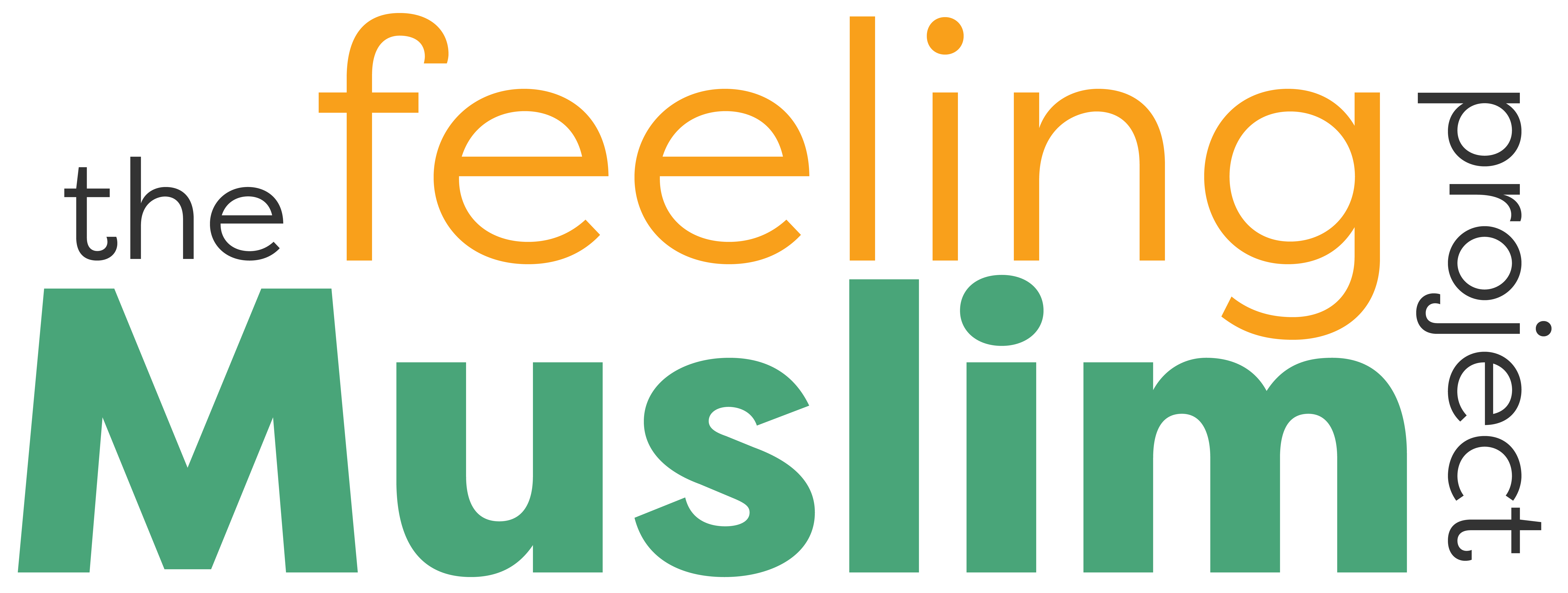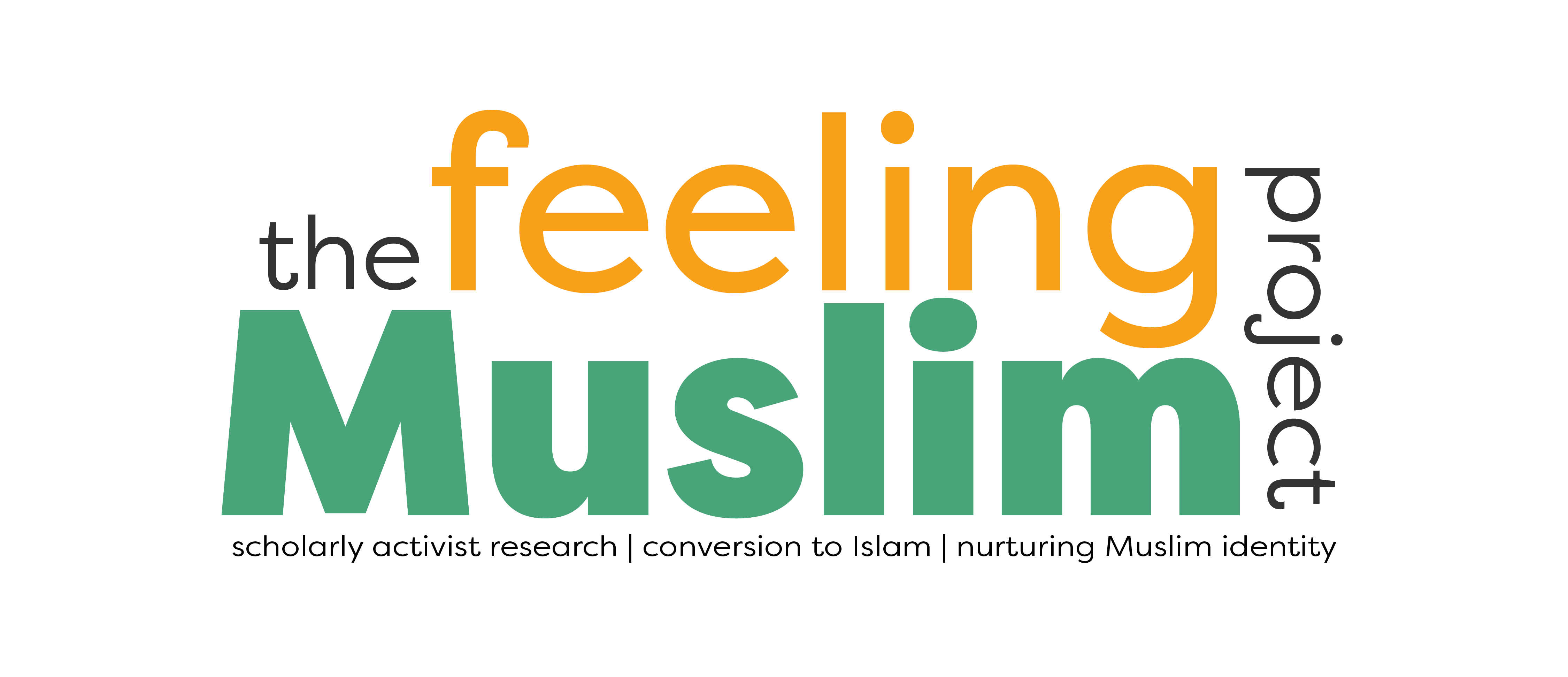The Study
The Feeling Muslim study is an in-depth mixed-methods survey of U.S. female converts to Islam. The information on this site focuses almost entirely on the socio-demographic data of 257 anonymous American female converts to Islam who responded to the survey Feeling Muslim: An Intimate Portrait of Identity Cultivation among American Female Converts to Islam. In 2014, there were a total of 459 responses to the survey. Of the 459 responses, 178 were partial responses, and 281 were full responses. Of the 281 full responses, 257 respondents identified as American (U.S.-born) female converts to Islam. Data from both partial and full responses will be utilized, with side-by-side comparisons for transparency and greater insight.


This project highlights and analyzes the responses of 257 anonymous American women converts to Islam who participated in the Feeling Muslim study.
The study questions are both quantitative (close-ended) questions and qualitative (open-ended), with the bulk of quantitative questions preceding the qualitative. Additionally, some questions have quantitative and qualitative elements. A complete sequential list of both quantitative and qualitative questions, as they appeared in the survey, is located in Appendix D of Feeling Muslim: Prolegomena to the Study of American Female Converts to Islam.
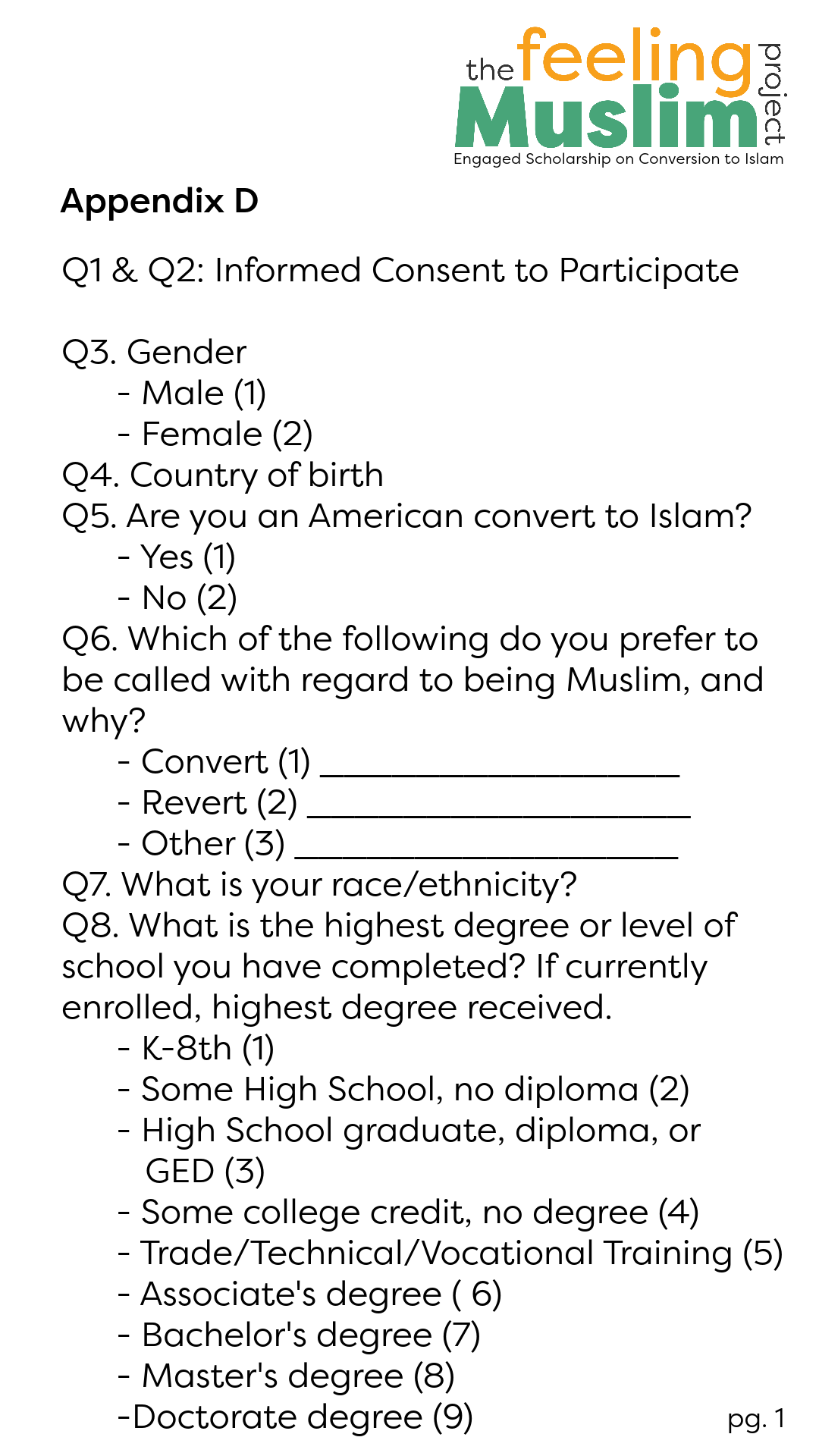
Questions 1-8 of the Feeling Muslim study
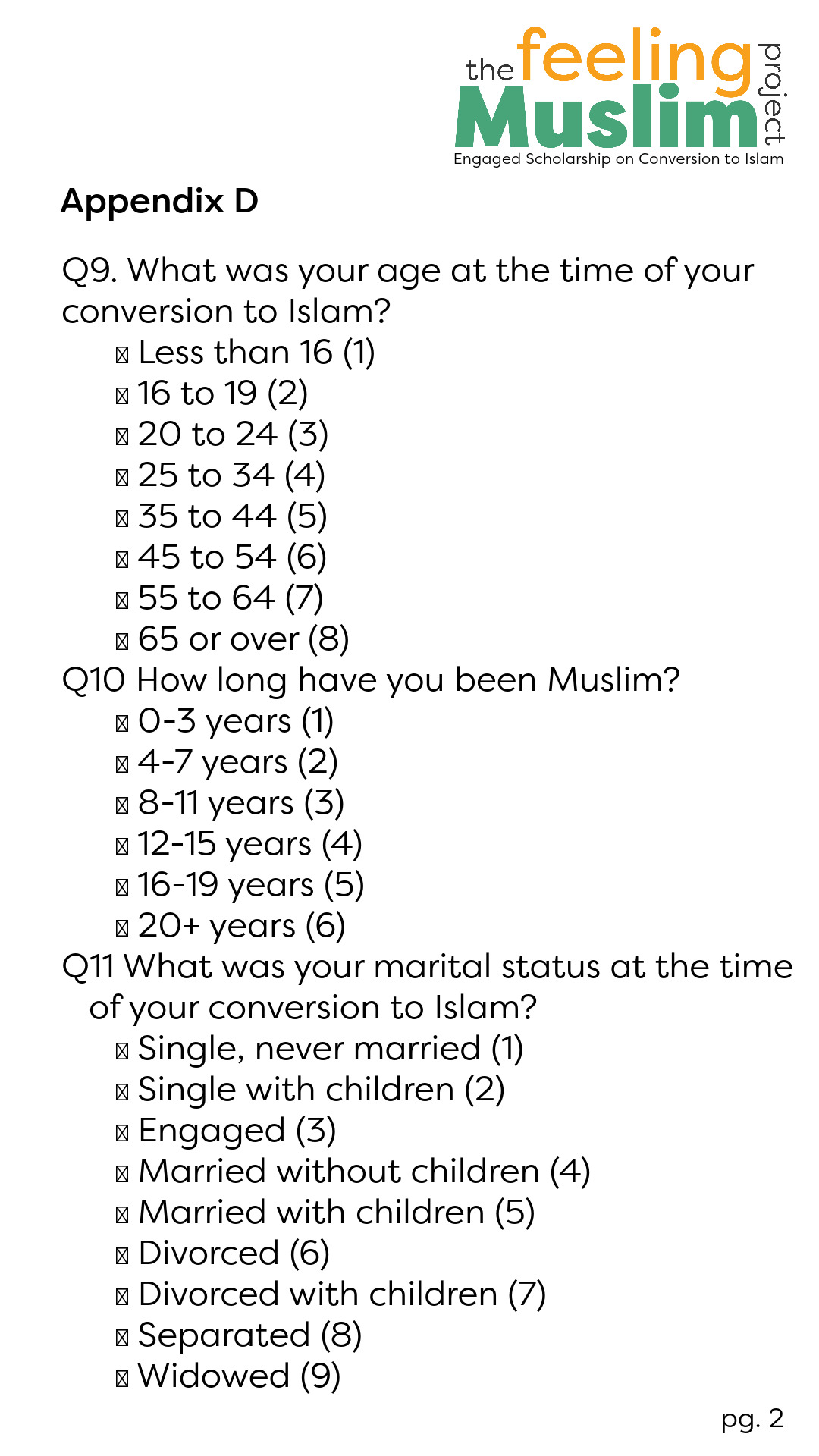
Questions 9-11 of the Feeling Muslim study
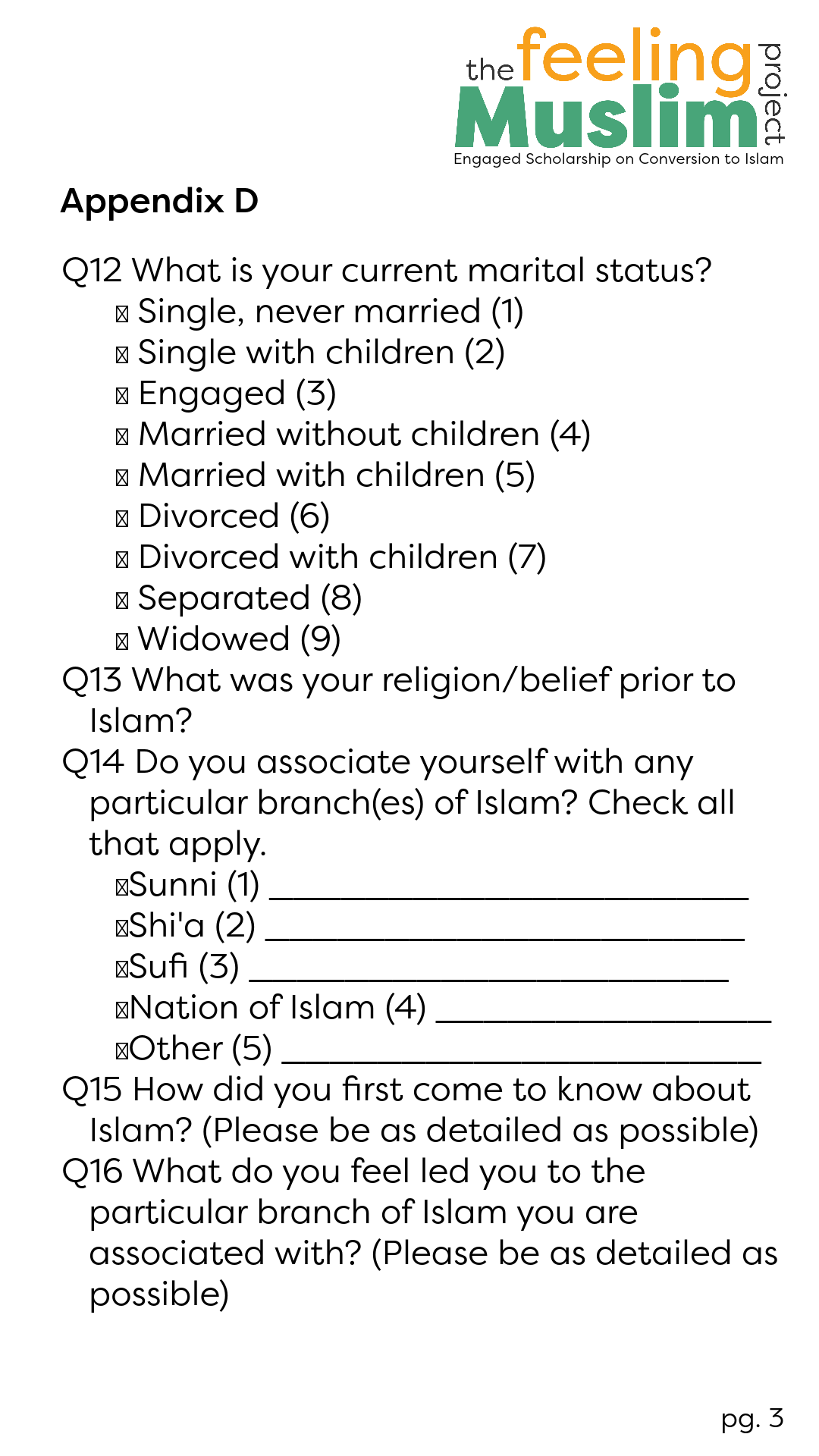
Questions 12-16 of the Feeling Muslim study
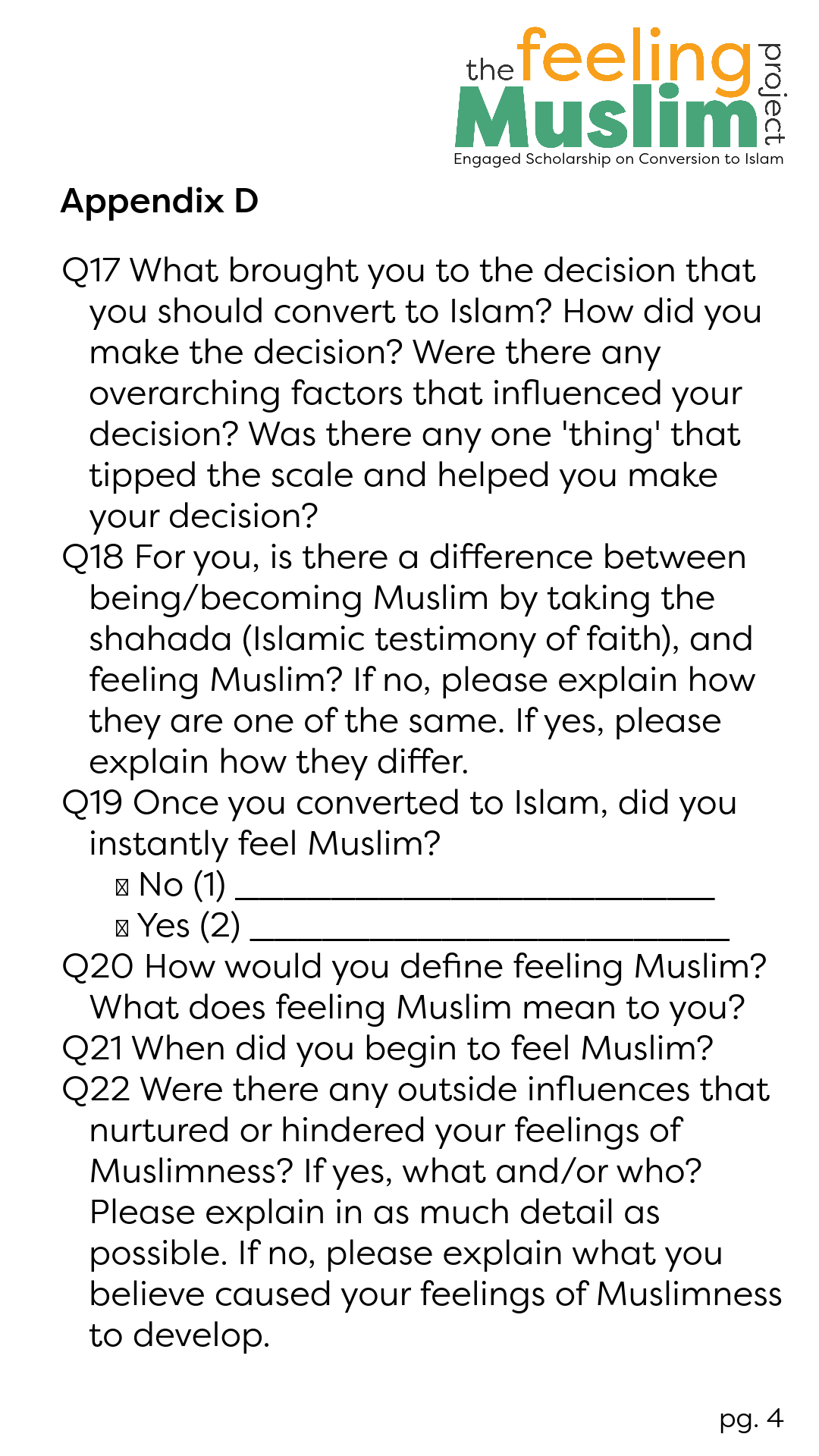
Questions 17-22 of the Feeling Muslim study
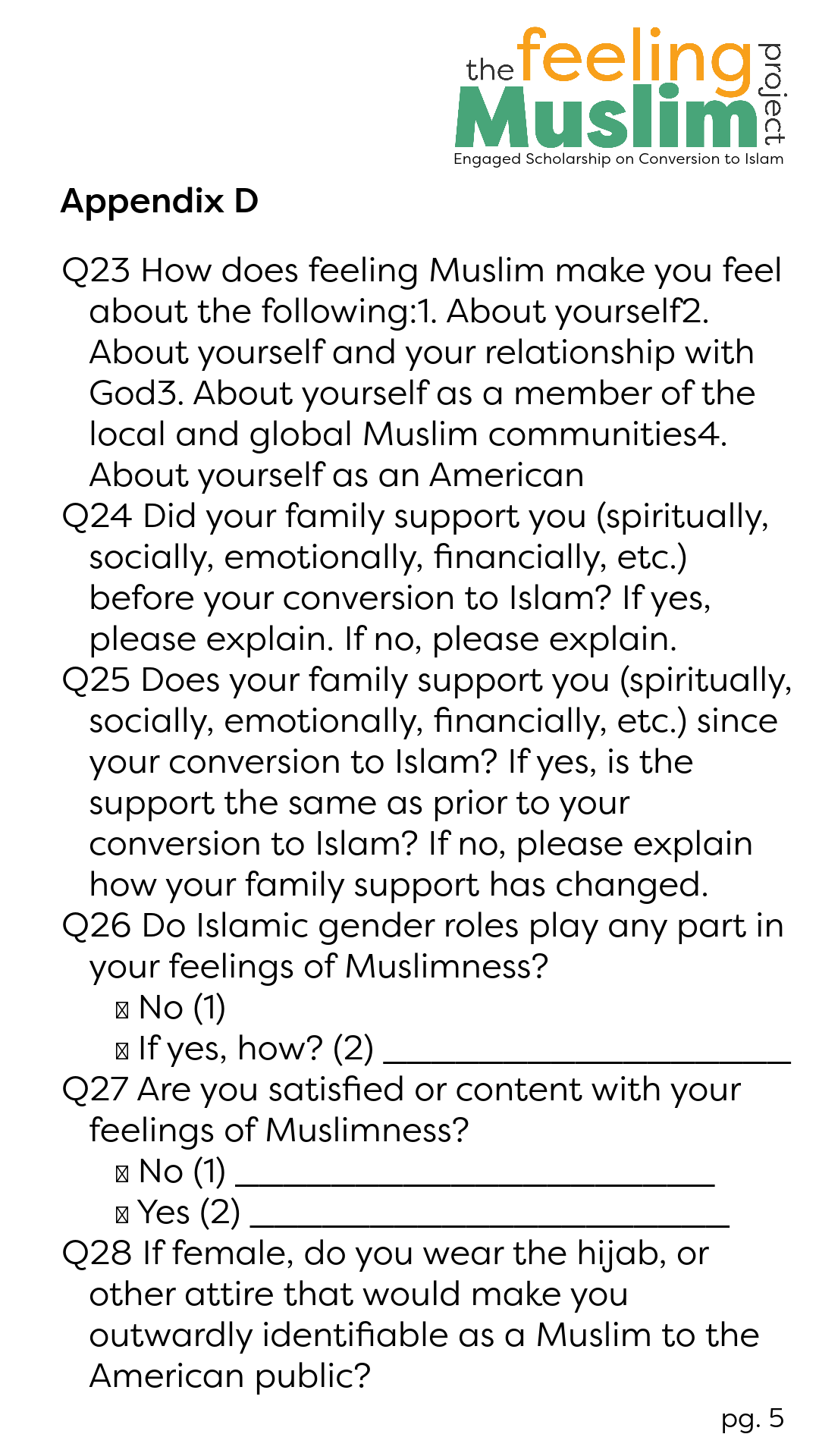
Questions 23-28 of the Feeling Muslim study
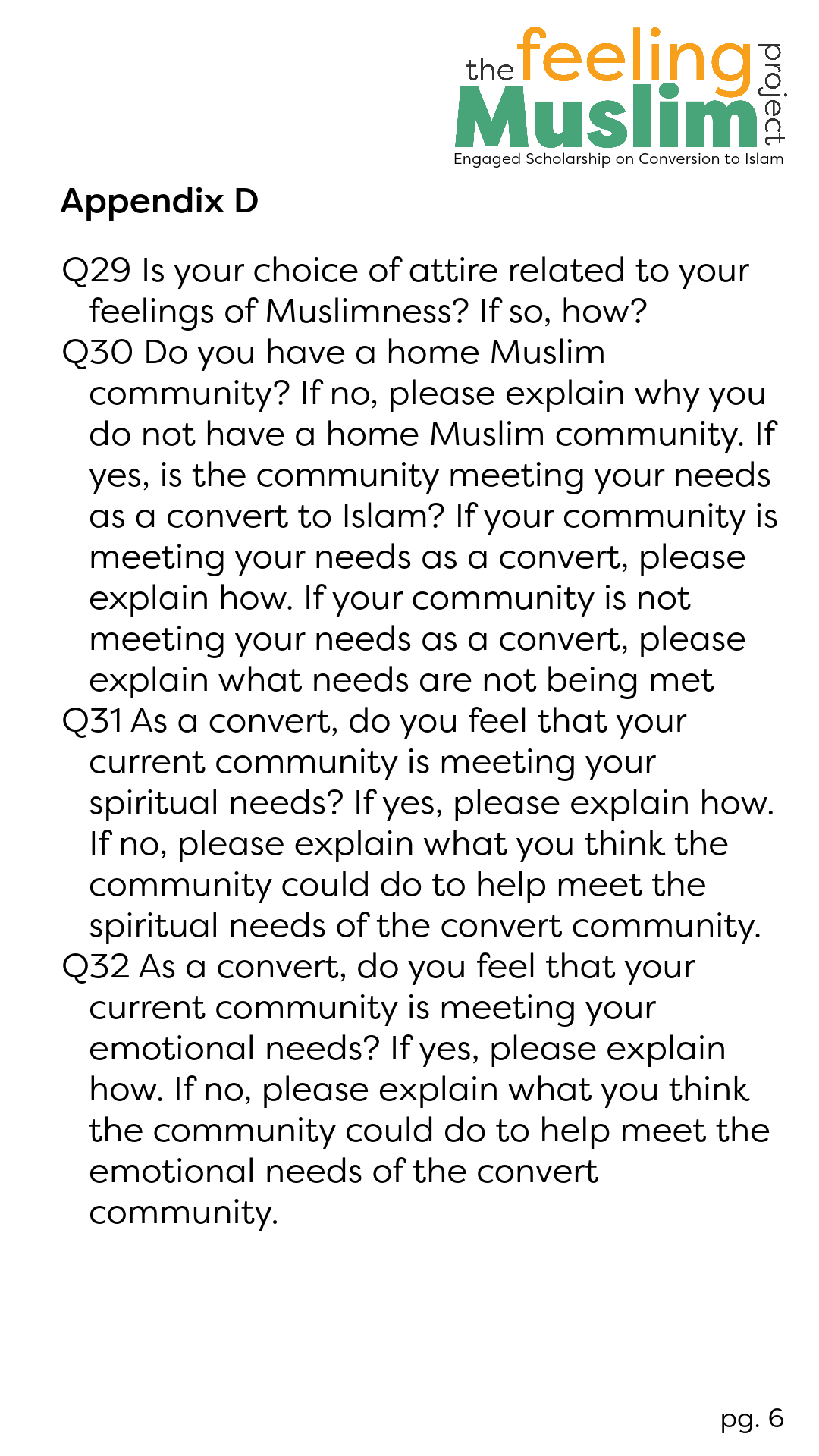
Questions 29-32 of the Feeling Muslim study
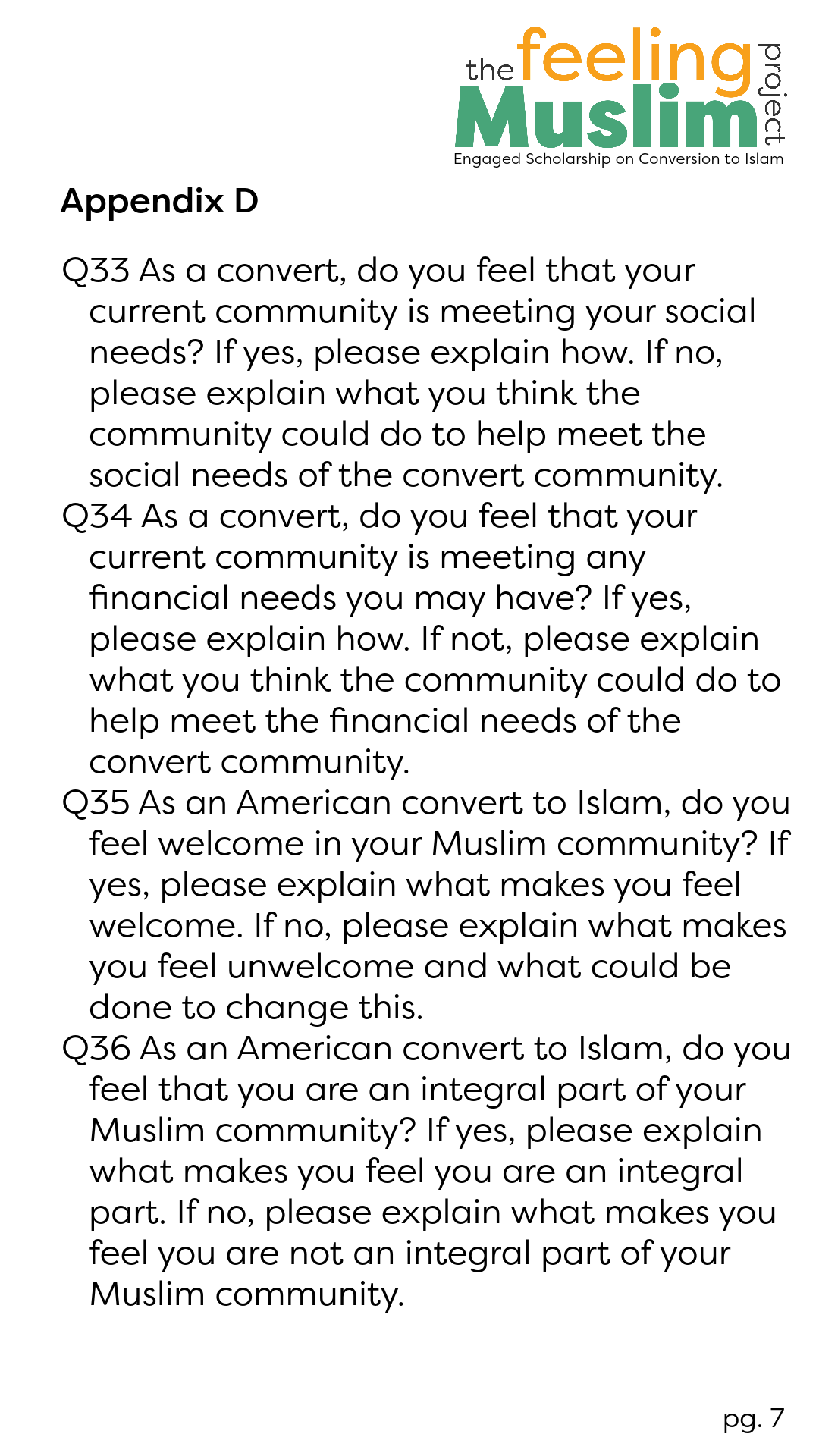
Questions 33-36 of the Feeling Muslim study
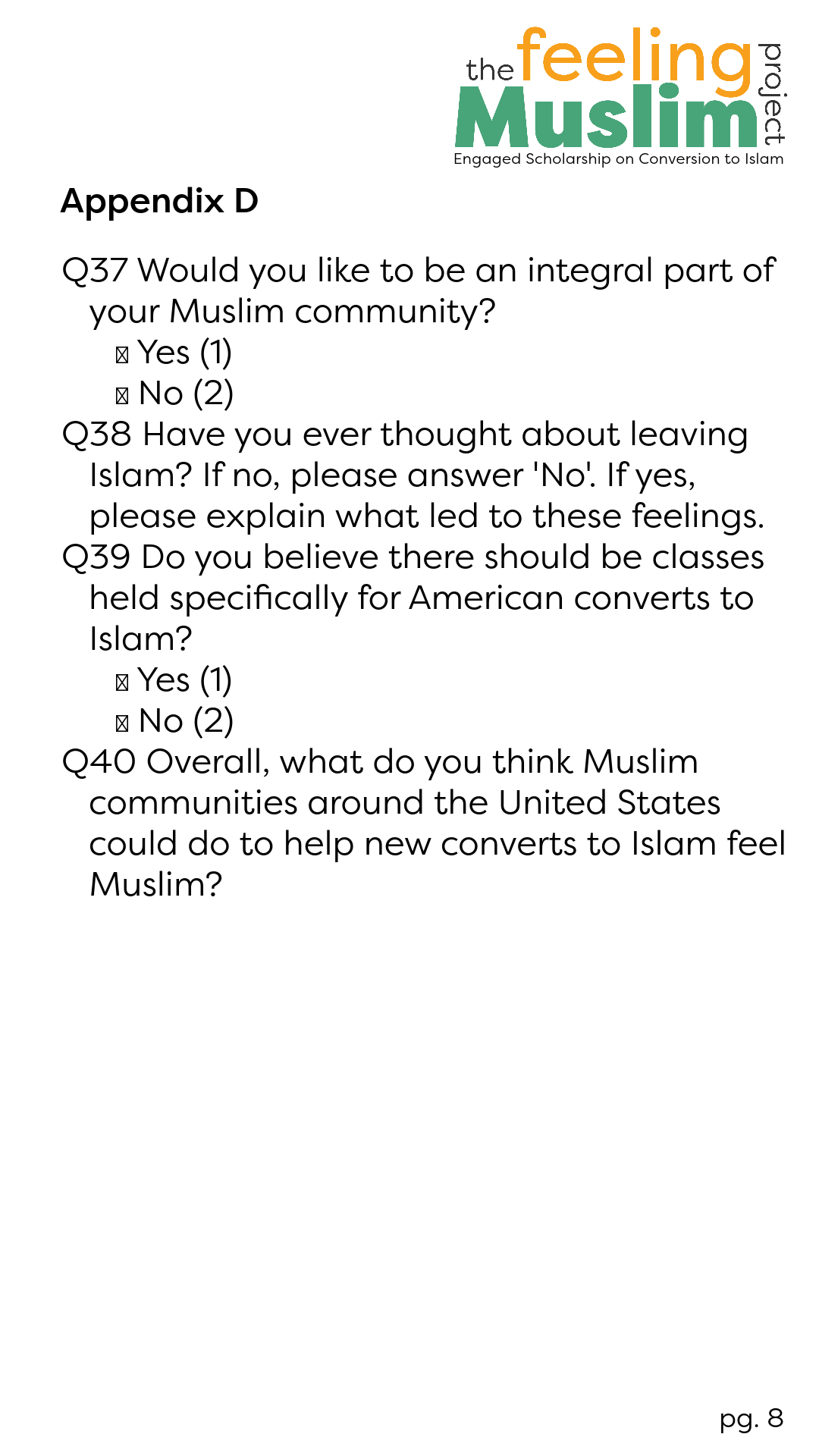
Questions 37-40 of the Feeling Muslim study
The Methodology
STUDYING CONVERTS: AN INTERACTIVE MIXED-METHODS DESIGN
Introduction
In contrast to research models that are not interactive, the design of this research models Joseph Maxwell’s Interactive Research Design, as presented in Qualitative Research Design: An Interactive Approach.[1] Maxwell’s design differs from similar models in his conceptualization of the relationship each component has with the others. Maxwell sees the design as a system in which each component is an integral part of the whole. The five components Maxwell identifies are Goals, Conceptual Framework, Research Questions, Methods, and Validity. While each part is integral, the research questions themselves are at the center of the design, and are the component that connects all other components to one another, and which have the most direct influence on the others, while simultaneously being the component most directly affected by the others. Maxwell’s model includes a detailed list of questions that each component should answer. What follows is an overview of the goals, conceptual framework, research questions, methods, and validity of the mixed-methods study, Feeling Muslim: An Intimate Portrait of Identity Cultivation among American Female Converts to Islam. In each subsequent section, I answer the questions corresponding to each component.
Goals[2], [3]
The study is worth doing for numerous reasons. Understanding, through the lens of this mixed-methods study, the nuances in the conversion experiences of American female converts to Islam, lends a greater understanding of the process of conversion to Islam as well as the identity cultivation process. Such an understanding is critical for identifying key factors in the development of feelings of Muslimness, as understood by American female converts to Islam, which may enable communities across the U.S. to better assist converts by reducing key factors converts identify as hindering their feelings of Muslimness, and increasing key factors converts identify as nurturing their feelings of Muslimness.


There are many issues surrounding American female converts to Islam, which require clarification. As previously mentioned, 73% of images the American public are seeing of Muslim women are portraying them as victims who desperately need to be rescued from oppression.[4] Sadly, portrayals such as these are not the exception, but the norm. However, these depictions of Muslim women do not at all equal the views Muslim women have of themselves. The responses to this mixed-methods study highlight the unadulterated views of American female converts to Islam and offer a drastically different narrative to counter the misconceptions. The hope is that by listening to the stories of these women, a shift will occur in the dialogue surrounding American female converts to Islam, which may ultimately effect change regarding public opinion.
Additionally, it is crucial to grasp what American female converts to Islam report about their experiences of becoming Muslim and feeling Muslim, as well as what distinctions, if any, the converts report, and how, if at all, they relate these two experiences. From a theoretical perspective, this research will extend existing literature on Muslim American women, which has primarily focused on first generation foreign-born immigrants and second and third generation U.S.-born immigrant families. It is important to understand how converts’ personal experiences both pre and post-conversion shape their eventual Muslim identities while exploring notions regarding what led to their conversions through research questions. On a practical level, the results will provide rich data on the firsthand views of this group and provide insights, which may be useful for Islamic studies educators in higher education, primary school, and at the local masjid level as well as schools of education planning for programs and student needs.
On a personal level, the results will lend a deeper understanding of the personal experiences of American female converts to Islam, who willingly became part of a religious minority in the United States upon conversion to Islam. The results will also help researchers explore the impact of community practices and structures on the lives of converts. The results of this research will also further a personal commitment to bringing convert issues to light in such a way that effects positive change for converts, individual Muslim communities, and U.S. society.
Scholars of Anthropology of Islam, Islamic Studies, Religious Studies, Women’s Studies, Anthropology of Religion, Sociology of Religion, Psychology of Religion, and many other fields, should care about this research because it gives the participants the opportunity to speak for themselves, participants are defining the subject, and the large sample size is representative across sects of Islam, races and ethnicities, classes, and sexual orientations. Additionally, the validity of the study strengthens by using a mixed-methods research design, independently analyzing each set of data before merging, and drawing on recent studies of Muslim Americans and American Mosques, which corroborate the findings.
Conceptual Framework[5]
The points below are adapted from Sherry L. Steeley’s dissertation proposal outline, Language, Culture, and Professional Identity: Cultural Productions in a Bilingual Career Ladder Training Program, which Maxwell cites as an example of interactive research design.[6]
We know very little about the identity formation and feelings of American female converts to Islam, as experienced by them, because there is very little research that specifically addresses convert issues and asks converts directly for input regarding solutions. This research addresses the following:
- — Studies of Muslim Americans do not necessarily apply to converts or include them, which leaves a gap in scholarly literature on the subject.
- — While there are numerous books and scholarly articles about converts to Islam, many are autobiographical and tell the story of one convert in particular or lead to generalizations about converts based on the experiences of a few.
- — To the best of my knowledge, no study yet exists regarding what helps female converts to Islam feel Muslim.
- — With 85% of full-time paid Imams being born outside the United States, Muslim American educators continue to struggle to adapt instruction and learning environments to the needs of culturally diverse learners, making it difficult for them to identify with the needs of American converts, and the U.S.-born children of immigrants.[7]
- — Research conducted on American mosques shows that only 3% of mosques consider classes for converts to Islam a top priority.[8]
- — As U.S. citizens who understand American cultural and societal norms, American female converts to Islam are in a good position to serve as advocates and change agents, not only for themselves, but also on behalf of their fellow Muslim Americans.
- — A majority of U.S. news media coverage of American female converts to Islam reflects bias toward Islam and portrays converts as brainwashed and oppressed victims.[9],[10],[11]
- — Understanding converts perceptions about their own identities, their ideas about community support, and what they need, is a first step toward understanding the important role U.S. converts to Islam can play in bridging the cultural divide between Muslims and other Americans.
- — Understanding how community support influences feelings of Muslimness may provide insight into the identity cultivation of converts as well as revealing steps that communities can take to nurture those feelings.
Thus, a mixed-methods study of American female converts to Islam, focusing on converts’ perspectives, can make an important contribution to the extant body of literature.
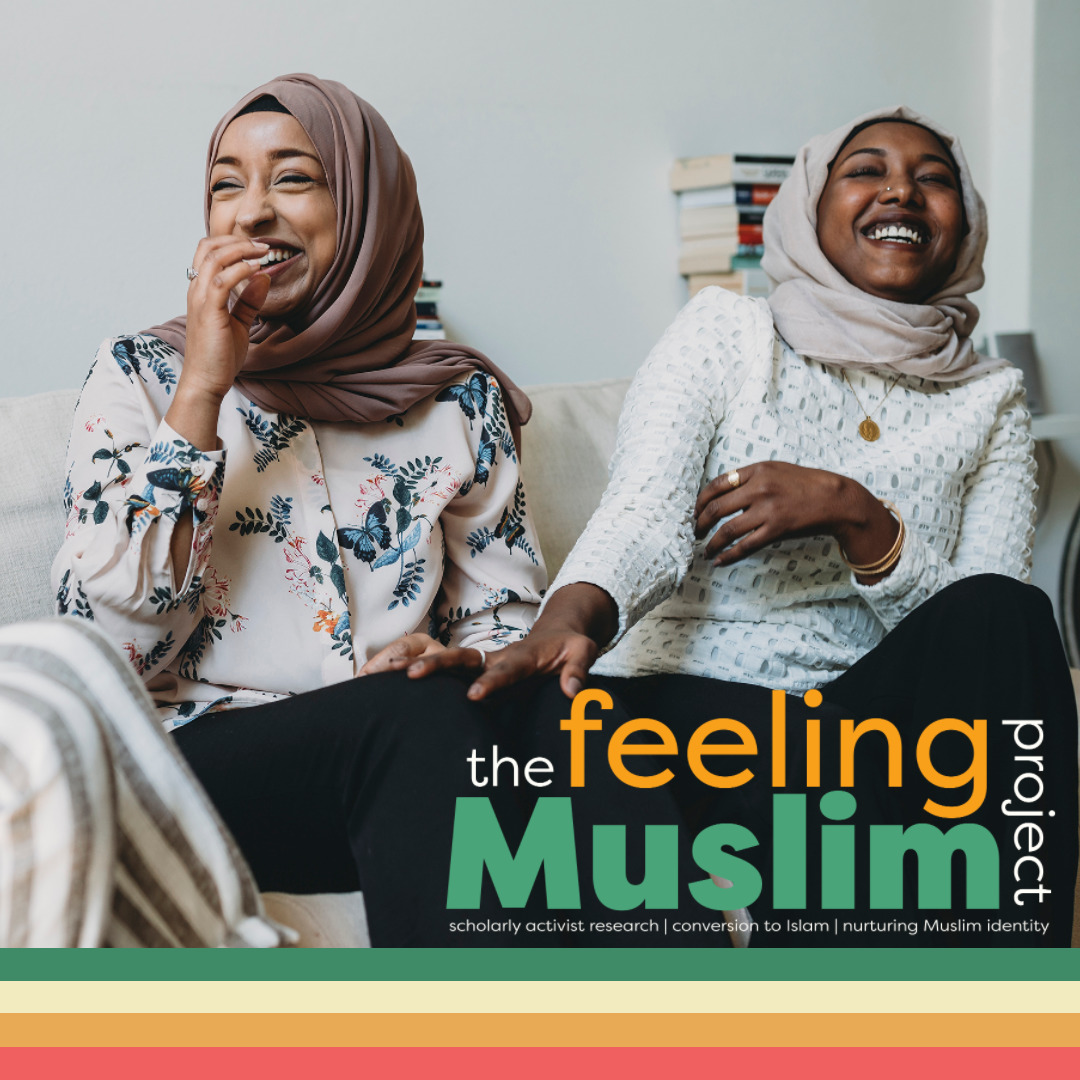
Research Questions[12]
First, the research sought to answer the following: Do converts distinguish between outwardly becoming Muslim and inwardly feeling Muslim. What did becoming Muslim and feeling Muslim mean to converts? What common characteristics do converts identify as ‘feelings of Muslimness’? Do converts identify stages in the cultivation of their Muslim identities? Moreover, do converts identify their needs as converts? By seeking to understand feelings of Muslimness as experienced by U.S. female converts, an intimate portrait of their individual and collective experiences develops.
While the aforementioned questions are the overarching questions, the mixed-methods survey itself, is broken down into quantitative and qualitative strands. A table of the quantitative questions is located in Appendix B.[13]
While, for the purpose of these tables, the numbering of questions is sequential, the quantitative and qualitative strands were intermixed throughout the survey, with the bulk of quantitative questions preceding the qualitative questions. Additionally, some questions had both quantitative and qualitative elements. A table of the qualitative questions is located in Appendix C. A complete sequential list of both quantitative and qualitative questions, as they appeared in the survey is located in Appendix D.
Methods[14]
This study represents an in-depth mixed-methods survey of 257 U.S. female converts to Islam. The definition of mixed methods research methodology, as understood herein, is as follows:
Mixed methods research is a research design with philosophical assumptions as well as methods of inquiry. As a methodology, it involves philosophical assumptions that guide the direction of the collection and analysis and the mixture of qualitative and quantitative approaches in many phases of the research process. As a method, it focuses on collecting, analyzing, and mixing both quantitative and qualitative data in a single study or series of studies. Its central premise is that the use of quantitative and qualitative approaches, in combination, provides a better understanding of research problems than either approach alone.[15]
This definition serves as a guide to understanding the approach to this research design, data collection, and data analysis.
With the decision to pursue a mixed-methods approach, came many important questions. As an American female convert to Islam myself, a series of self-reflective questions arose. Would I be comfortable with a stranger sitting in front of me, asking me these questions, and recording my answers? Would I be comfortable with someone having the ability to tell others about my intimate feelings and possibly revealing my identity? My answer was, “No.” Therefore, the line of questioning changed and I began to ask myself, “Which method would help the respondents feel more comfortable with regard to answering these personal questions?” The solution was simple, anonymity. However, how could I ensure the anonymity of the respondents if the questioning was occurring face-to-face? Such a thing is uninsurable. Thus, the decision to make the survey online and anonymous arose. Initially, my inner anthropologist and ethnographer did not like the idea at all. How could the research be ethnographic if there was no face-to-face interaction? The answer was simple enough. By asking open-ended qualitative questions and quantitative questions with built-in follow-up questioning, the research would retain an equally strong qualitative element.
For the distribution of the survey, the decision to turn to social media was an easy one. The goal was to reach as many potential participants as possible, while simultaneously retaining anonymity. Thousands of women received a link to the survey via messages, message boards, and postings on Facebook, Twitter, and Yahoo Groups. Additionally, outreach extended to numerous Islamic organizations across the United States via e-mail, in hopes that they would forward the information to American female converts in their respective communities. While many individuals and organizations were receptive and aided a great deal in the distribution of the survey, others chose not to distribute the survey or tell their members about the study. The distribution of the survey began on June 20, 2014 and ended on September 23, 2014, for a total of three months.
Upon pursuing a mixed-methods approach, the choosing of a research design commenced. After researching various mixed methods designs and discussing them with the committee as well as fellow colleagues, I chose a convergent, parallel data-validation variant of mixed methods design, which would allow me to include both open-ended (qualitative) and closed-ended (quantitative) questions on the survey. By using this variant of the convergent design, the results from the qualitative questions can be used to confirm, validate, or invalidate the results from the quantitative questions.[16]
Regarding data analysis, responses to qualitative and quantitative questions are coded, categorized, and analyzed on an ongoing basis as a source for further questions, the emergence of themes, and as an eventual source for organizing patterns of response across categories and individuals. Additionally, qualitative responses serve as further basis of discussion according to themes, providing a source to compare and contrast beliefs, practices, thinking, and identity. To verify the findings and themes, I will undertake extensive member checks of the findings and participant responses on an ongoing basis.
To deepen the understanding of the data, I discuss qualitative responses and accompany the quantitative results with diagrams. The data analysis follows a convergent, data-validation variant of mixed methods design. Initially, the analysis of the quantitative and qualitative strands happens independently, then a merger of the results occurs, followed by a summarization and interpretation of the merged results, ending with a discussion of the extent to which, and in what ways results from both sets of data converge, diverge, relate to each other, and/or produce a more complete understanding. This description is adapted from the flowchart for implementing a convergent design as presented in Creswell.[17] The flowchart provides a brief overview of the basic procedures for implementing a convergent, parallel mixed methods design.
Validity[19]
There are numerous ways my results and conclusions could be wrong. While a great effort was made to reach as many American female converts to Islam, some communities proved more difficult to reach than others. Thus, those communities I was unable to reach may not be represented evenly in the conclusions or may be underrepresented due to a poor sample size. For example, although African-American female converts to Islam outnumber Caucasian female converts to Islam, far more Caucasian converts completed the survey than African-American converts. This is something to take into consideration when analyzing the responses.
Figure 1: Flowchart of the Basic Procedures in Implementing a Convergent Design[1]
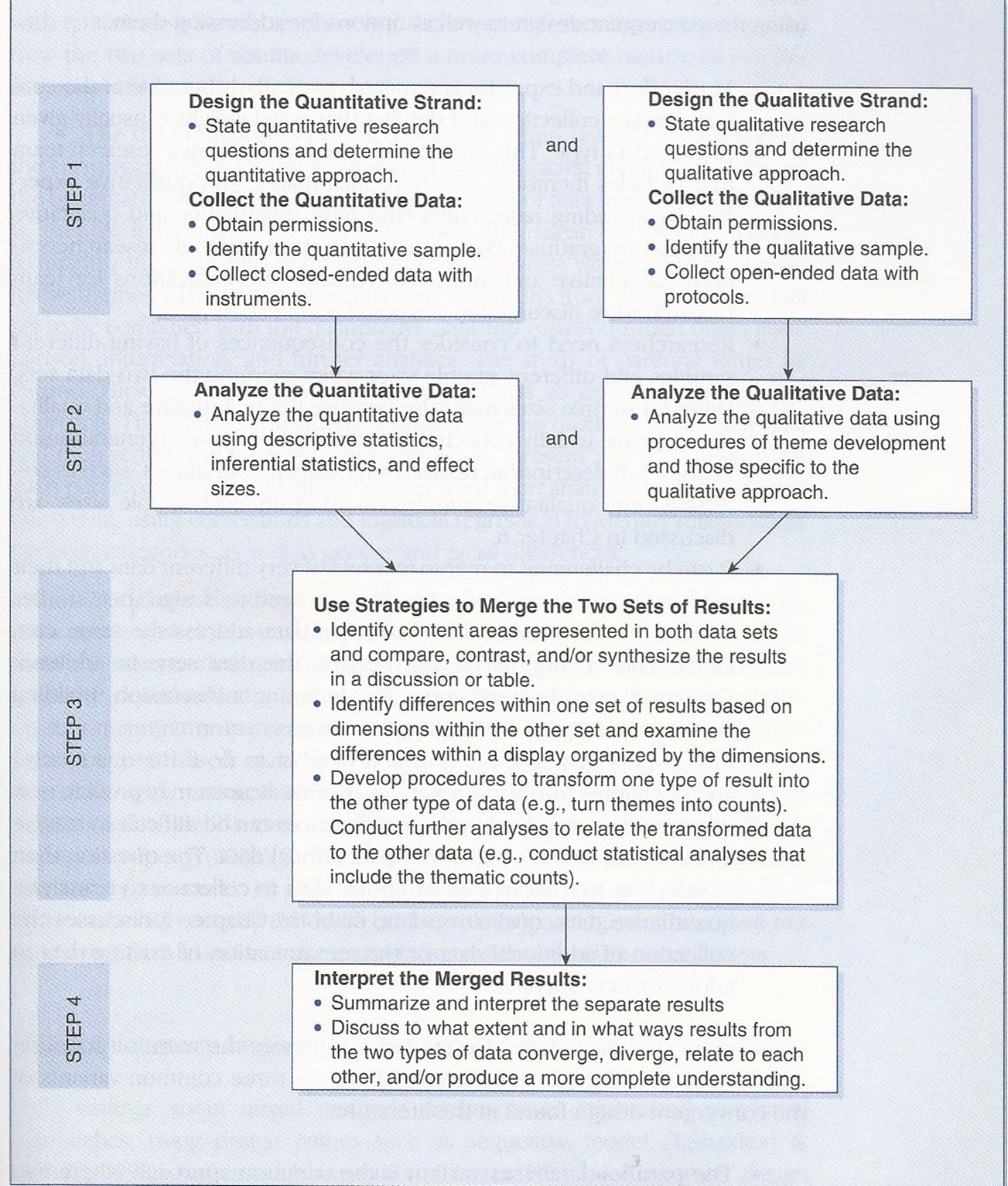
Figure 2 (This chart is figure 3.3 in Creswell’s book): Flowchart of the Basic Procedures in Implementing a Convergent Design[18]
[1] Ibid., from figure 3.3, pg. 79.
To deal with ‘reactivity’ and ‘hesitation’ on the part of potential participants, I emphasized that I support converts as a fellow American female convert to Islam and that I am interested in learning and understanding more about their views and experiences. To deal with my own biases, I am exercising extensive self-reflection and reflexivity as I proceed through data collection and analysis, raising my own awareness.
Regarding verification techniques, there will be frequent member-checks of qualitative and quantitative responses. Additionally, there will be active searches for discrepant evidence by using informed surveying techniques, and placing emphasis on discrepant evidence in member checks. Lastly, I am actively seeking informed input from colleagues and committee members while undertaking reflection and analysis of qualitative and quantitative responses to ensure that the degree to which my own biases could influence the findings, is diminished.
Rather than to identify a generalizable phenomenon, findings are intended to provide a more accurate and comprehensive understanding of U.S. female converts to Islam for academics and other interested parties such as policy makers, Islamic educators, administrators of mosques, as well as members of Muslim communities all over the United States.
The results herein deserve consideration as valid due to the large sample size obtained (257 responses), having representative samples across sects of Islam, races and ethnicities, age at the time of conversion, education, location, length of time as a Muslim, marital status at conversion, current marital status, and choice of attire. Additionally, the validity of the study increased due to employing a mixed-methods approach to the research and independent analysis of each data set before merging. Most importantly, these results should be relevant because the research allows converts to speak for themselves; define the subject of feeling Muslim; outline their personal journeys; detail some key factors of their feelings of Muslimness; convey what makes them feel Muslim; and educate others on how they can nurture or hinder the cultivation of those feelings.
References
[1] Joseph Alex Maxwell, Qualitative Research Design : An Interactive Approach, 3rd ed., Applied Social Research Methods (Thousand Oaks, Calif.: SAGE Publications, 2013).
[2] Ibid. Joseph Maxwell outlines five components, which are similar to those put forth, by Margaret LeCompte and Judith Preissle in 1993 in Ethnography and Qualitative Design in Educational Research. Dr. Judith Preissle is a distinguished professor of Qualitative Research at the University of Georgia. In preparation for this study, I began my journey into qualitative research as a student in her course, Qualitative Research Traditions.
[3] Margaret Diane LeCompte, Judith Preissle, and Renata Tesch, Ethnography and Qualitative Design in Educational Research / Margaret D. Lecompte, Judith Preissle, with Renata Tesch (San Diego : Academic Press, c1993. 2nd ed., 1993), Bibliographies. Non-fiction.
[4] Gardner, “Inside Islam: What a Billion Muslims Really Think.”
[5] Maxwell, Qualitative Research Design : An Interactive Approach.
[6] Ibid.
[7] Ihsan Bagby, “The American Mosque 2011: Activities, Adminstration and Vitality of the American Mosque,” (Islamic Society of North America, 2012). This study is part one of a three part series that culminated with the production of a documentary of the findings called, Unmosqued, which premiered in 2014.
[8] Ibid.
[9] Haddad, Smith, and Moore, Muslim Women in America: The Challenge of Islamic Identity Today.
[10] Gardner, “Inside Islam: What a Billion Muslims Really Think.”
[11] Omar Sacirbey, “Female Converts to Islam Face Growing Scrutiny,” Christian Century 130, no. 11 (2013).
[12] Maxwell, Qualitative Research Design : An Interactive Approach.
[13] A copy of the entire survey, Feeling Muslim: An Intimate Portrait of Identity Cultivation among American Female Converts to Islam is located in Appendix D.
[14] Maxwell, Qualitative Research Design : An Interactive Approach.
[15] John W. Creswell and Vicki L. Plano Clark, Designing and Conducting Mixed Methods Research / John W. Creswell, Vicki L. Plano Clark (Thousand Oaks, Calif. : SAGE Publications, c2007., 2007), Bibliographies. Non-fiction.
[16] Designing and Conducting Mixed Methods Research / John W. Creswell, Vicki L. Plano Clark.
[17] Ibid.
[18] Ibid., from figure 3.3, pg. 79.
[19] Maxwell, Qualitative Research Design : An Interactive Approach.
For citation purposes
Chicago Style:
Karla Nicole Evans, Feeling Muslim: Prolegomena to the Study of American Female Converts to Islam [Electronic Resource], by Karla Nicole Evans (2015).Bibliographies. Theses. Non-fiction.
